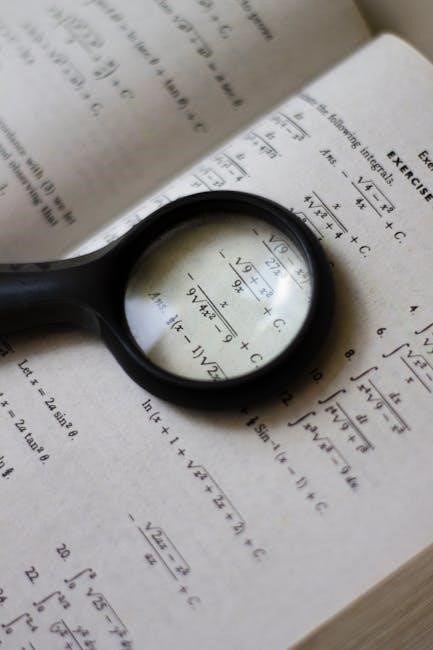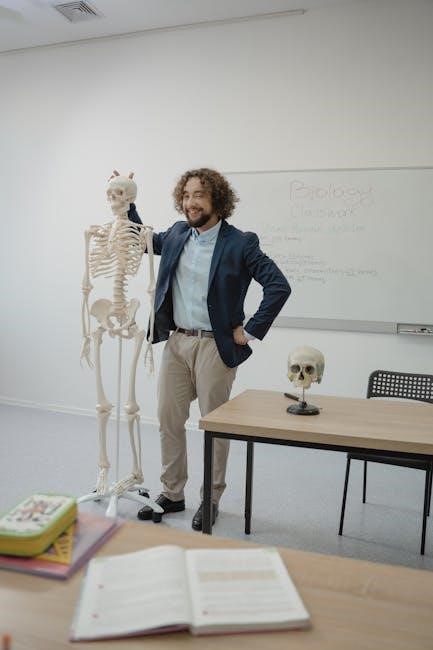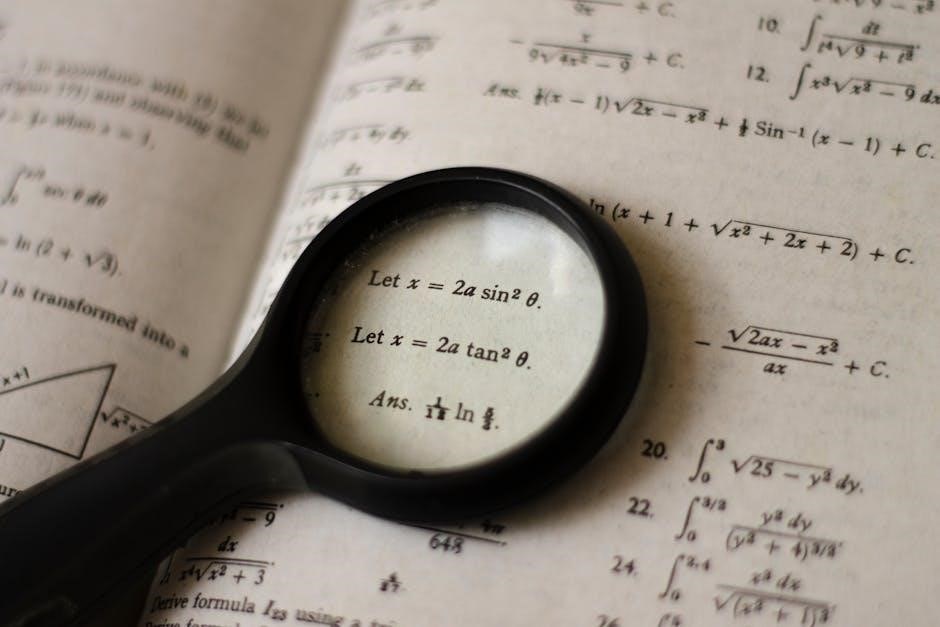Australian Curriculum Maths Year 7 Textbook PDF: A Comprehensive Guide
Navigating Year 7 Maths in Australia can be simplified with the right textbook. A PDF version offers convenience and accessibility. This guide explores the Australian Curriculum, key content, and where to find helpful resources. It will also discuss commercial options.
Overview of the Australian Curriculum: Mathematics
The Australian Curriculum: Mathematics shapes maths education nationwide. It focuses on developing essential mathematical skills and knowledge. The curriculum emphasizes understanding, fluency, problem-solving, and reasoning. These are the core proficiency strands. These strands are integral to learning across all content areas.

The curriculum is structured around three content strands: Number and Algebra, Measurement and Geometry, and Statistics and Probability. These strands define what students should learn at each year level. For Year 7, the curriculum builds upon concepts introduced in earlier years. It introduces more complex mathematical ideas.
Resources and support materials are available as PDF documents. This includes content sequences and achievement standards. The curriculum aims to equip students with the ability to apply maths in real-world contexts. It also prepares them for further studies. Teachers are encouraged to incorporate Indigenous perspectives into lessons. This curriculum is designed to be adaptable and inclusive.
Key Content Strands in Year 7 Maths
Year 7 Maths in Australia, guided by the Australian Curriculum, consists of three primary content strands. These are Number and Algebra, Measurement and Geometry, and Statistics and Probability. Each strand covers specific mathematical concepts and skills. It aims to build a strong foundation for future learning.
Number and Algebra involves working with integers, fractions, decimals, and percentages. Students learn to represent numbers using variables. They connect number properties to algebra. They also evaluate algebraic expressions. This strand develops skills in manipulating and solving equations.
Measurement and Geometry focuses on understanding angles, shapes, and their properties. Students explore measurement units and apply them to real-world problems. They investigate geometric relationships and spatial reasoning.
Statistics and Probability introduces students to data collection, representation, and interpretation. They learn to calculate probabilities and analyze data sets. The proficiency strands of understanding, fluency, problem-solving, and reasoning are integrated throughout. These strands ensure a comprehensive and well-rounded maths education.
Number and Algebra in Year 7
In Year 7 Maths, the Number and Algebra strand builds upon prior knowledge, introducing more complex concepts. Integers, decimals, fractions, and percentages form a core part of the curriculum. Students learn to perform operations with these numbers, including addition, subtraction, multiplication, and division;
A significant focus is placed on understanding and converting between different forms of numbers. This includes representing fractions, decimals, and percentages interchangeably. Students also explore squares, cubes, square roots, and cube roots of fractions.
Algebraic thinking is developed through the introduction of variables and expressions. Students learn to represent numbers using variables, connecting number laws to algebraic principles. They practice evaluating algebraic expressions and solving simple equations. The curriculum emphasizes the importance of understanding the properties of numbers and applying them to algebraic contexts.
Furthermore, students begin to explore number patterns and relationships. This involves identifying and extending sequences, as well as representing them algebraically. The goal is to foster a deeper understanding of number systems and their applications in problem-solving.
Measurement and Geometry in Year 7
The Measurement and Geometry strand in Year 7 Maths focuses on developing spatial reasoning and practical measurement skills. Students explore concepts such as area, volume, perimeter, and angle properties. They learn to apply these concepts to solve real-world problems involving two-dimensional and three-dimensional shapes.
A key aspect of this strand is understanding and using appropriate units of measurement. Students work with metric units for length, area, volume, and capacity. They also learn to convert between different units and estimate measurements accurately.
Geometric concepts are introduced and explored through hands-on activities and visual representations. Students learn about different types of angles, including acute, obtuse, right, and reflex angles. They also investigate the properties of triangles, quadrilaterals, and other polygons.
Furthermore, students develop their spatial reasoning skills by working with transformations such as translations, rotations, and reflections. They learn to identify and describe these transformations, as well as their effects on geometric shapes. The use of digital tools and manipulatives is encouraged to enhance understanding and engagement.
Statistics and Probability in Year 7
In Year 7, the Statistics and Probability strand introduces students to fundamental concepts of data analysis and chance. Students begin by collecting, organizing, and representing data using various methods such as tables, charts, and graphs. This involves understanding different types of data, including categorical and numerical data, and selecting appropriate display methods to effectively communicate findings.
A key focus is on interpreting and analyzing data displays to draw conclusions and make inferences. Students learn to identify patterns, trends, and relationships within data sets. They also explore measures of center, such as mean, median, and mode, to summarize and compare data distributions. Understanding the strengths and limitations of each measure is emphasized.
The concept of probability is introduced through hands-on experiments and simulations. Students learn to calculate the probability of simple events and understand the difference between theoretical and experimental probability. They also explore the use of probability to make predictions and assess the likelihood of different outcomes.
Throughout this strand, critical thinking and problem-solving skills are developed as students analyze data, interpret probabilities, and make informed decisions based on evidence.
Proficiency Strands: Understanding, Fluency, Problem Solving, Reasoning

The Australian Curriculum: Mathematics emphasizes four proficiency strands that are integral to learning. These strands are Understanding, Fluency, Problem Solving, and Reasoning. They are not separate topics but rather interwoven aspects of mathematical learning that should be developed concurrently.
Understanding involves connecting mathematical concepts and representations. Students demonstrate understanding when they can explain why a particular concept or method works. Fluency refers to the ability to efficiently and accurately apply mathematical skills and procedures. This includes recalling facts, using mental strategies, and performing calculations with speed and precision.
Problem Solving requires students to formulate, represent, and solve mathematical problems. This involves selecting appropriate strategies, applying knowledge, and interpreting solutions in context. Reasoning involves logical thought, justification, and proof. Students demonstrate reasoning when they can explain their thinking, make generalizations, and justify conclusions.
These proficiency strands are embedded within the content strands of Number and Algebra, Measurement and Geometry, and Statistics and Probability. Effective teaching should integrate these proficiencies to promote a deep and connected understanding of mathematics. Textbooks and resources should provide opportunities for students to develop all four proficiencies.
Finding Year 7 Maths Textbook PDFs Online

Locating Year 7 Maths textbook PDFs online requires careful navigation due to copyright restrictions. Official textbooks are rarely available as free PDFs. However, some resources may offer sample chapters or supplementary materials in PDF format.
Start by checking the publisher’s website. Major publishers like Oxford, Cambridge, and Jacaranda often provide digital resources, including excerpts from their textbooks. Educational websites and online learning platforms may also offer free worksheets and practice questions in PDF format, aligned with the Australian Curriculum.
Be cautious when searching for full textbook PDFs on unofficial websites. These sources may contain pirated content or malware. Always prioritize legal and reputable sources. Libraries sometimes offer digital access to textbooks through their online platforms, so check your local library’s website.
Consider exploring open educational resources (OER) websites. These platforms provide free and openly licensed educational materials, including maths resources. While a complete textbook PDF may be difficult to find, combining various online resources can provide comprehensive support for Year 7 Maths. Remember to verify the alignment of any resource with the Australian Curriculum.
Free Resources for Year 7 Maths
Numerous free resources exist to support Year 7 Maths learning, aligning with the Australian Curriculum. Websites like Australian Curriculum Lessons offer a vast range of lesson plans and teaching materials created by teachers. These resources cover various topics within the Number and Algebra, Measurement and Geometry, and Statistics and Probability strands.
IXL offers a selection of free practice questions, although a full subscription provides more comprehensive coverage. Math-Aids.com provides dynamically generated math worksheets in PDF format, offering endless practice opportunities. DadsWorksheets.com is another great resource for free, printable math worksheets.
ABC Education provides free videos and interactive activities that bring maths concepts to life. Educational platforms, like those offered by Ochre Education, sometimes provide sample lessons and resources for free. Many teachers share their resources on platforms like Teachers Pay Teachers, where you can find both free and paid materials.
Remember to check the alignment of any resource with the Australian Curriculum. Utilize these free resources to supplement textbook learning and enhance understanding of key mathematical concepts. By combining these resources, students can build a strong foundation in Year 7 Maths.
Commercial Textbook Options and Features
Several commercial textbook options cater to the Year 7 Australian Curriculum Maths syllabus. These textbooks often come with comprehensive content coverage, practice exercises, and digital resources. Publishers like Jacaranda, Pearson, and Cambridge offer popular choices.
Jacaranda Maths Quest provides access to Years 7-10 content, promoting flexibility and tracking student progress. Pearson Mathematics, rewritten for the Australian Curriculum V9;0, includes digital lessons with videos and auto-correcting quizzes. CambridgeMATHS NSW aims to align with the NSW syllabus, incorporating interactive elements.
These textbooks typically integrate the proficiency strands: understanding, fluency, problem-solving, and reasoning. Features often include worked examples, diagnostic quizzes, and extended response questions. Many offer online platforms with interactive exercises, videos, and assessment tools.
When selecting a commercial textbook, consider its alignment with the specific curriculum requirements, the availability of digital resources, and the teaching style. Compare features like the clarity of explanations, the variety of practice questions, and the level of support offered to both students and teachers. Ultimately, the best choice will depend on individual needs.

Digital Learning Platforms and Resources
Digital learning platforms and resources are increasingly important in Year 7 Maths education. These platforms offer interactive exercises, videos, and personalized learning experiences. They complement traditional textbooks and provide engaging ways for students to learn and practice mathematical concepts.
IXL offers comprehensive coverage of the Australian Year 7 curriculum with dynamic maths practice skills. ClickView partners with Oxford University Press to deliver curriculum-aligned videos for secondary schools. These videos can enhance understanding and provide visual explanations of concepts.
Many commercial textbook publishers, such as Jacaranda and Pearson, offer online platforms with interactive features. These platforms often include auto-correcting quizzes, worked examples, and assessment tools. Some platforms also provide personalized learning paths and track student progress.
Free websites like Australian Curriculum Lessons provide access to lesson plans, teaching resources, and unit overviews. Math-Aids.com produces dynamic math worksheets in PDF format. These resources can supplement textbook material and provide additional practice opportunities.
When choosing digital learning platforms, consider their alignment with the Australian Curriculum, the quality of the content, and the level of interactivity. Look for platforms that offer personalized learning experiences and track student progress. Remember to balance digital resources with traditional textbook learning for a well-rounded education.
Integrating Indigenous Perspectives in Maths
Integrating Indigenous perspectives into Year 7 Maths lessons provides a rich and culturally relevant learning experience for students. This approach acknowledges the mathematical knowledge and practices embedded in Indigenous cultures, promoting inclusivity and respect for diverse ways of knowing.
One way to integrate Indigenous perspectives is to explore traditional Indigenous technologies and practices that involve mathematical concepts. This can include studying Indigenous navigation techniques, which rely on spatial reasoning and geometric principles. Another approach is to examine Indigenous art and designs, which often incorporate patterns, symmetry, and geometric shapes.
Teachers can also incorporate Indigenous storytelling and dance into maths lessons. These activities can provide a context for understanding mathematical concepts and make learning more engaging. For example, a story about Indigenous land management practices can illustrate concepts related to measurement, area, and volume.
It’s crucial to consult with local Indigenous communities and Elders to ensure that the integration of Indigenous perspectives is authentic and respectful. This may involve inviting Indigenous knowledge holders to share their expertise with students or using resources developed by Indigenous organizations.
By integrating Indigenous perspectives into Year 7 Maths, students can develop a deeper understanding of mathematical concepts and appreciate the diversity of mathematical knowledge systems. This approach fosters cultural awareness, promotes reconciliation, and enriches the learning experience for all students.
Assessment and Reporting in Year 7 Maths
Assessment in Year 7 Maths is a crucial component of the learning process, providing valuable insights into student understanding and progress. It informs teaching practices and helps identify areas where students may need additional support.
A variety of assessment methods should be used to gain a comprehensive understanding of student learning. These can include formative assessments, such as in-class activities, quizzes, and observations, which provide ongoing feedback and allow teachers to adjust their instruction accordingly. Summative assessments, such as tests, projects, and assignments, are used to evaluate student learning at the end of a unit or term.
Assessment tasks should align with the Australian Curriculum: Mathematics and assess students’ understanding of the content strands (Number and Algebra, Measurement and Geometry, and Statistics and Probability) and the proficiency strands (Understanding, Fluency, Problem Solving, and Reasoning).
Reporting on student achievement in Year 7 Maths should be clear, informative, and based on evidence gathered through various assessment methods. Reports should provide information on students’ strengths and areas for improvement, as well as their overall level of achievement.
Effective assessment and reporting practices in Year 7 Maths contribute to student learning by providing valuable feedback, informing teaching practices, and promoting student self-reflection. They also ensure that parents and guardians are well-informed about their child’s progress in mathematics.